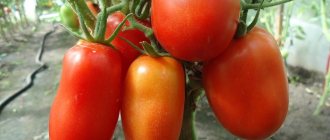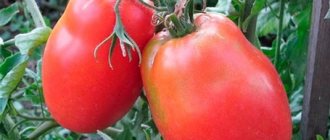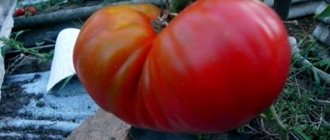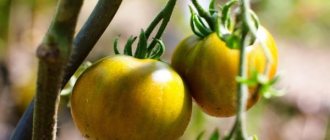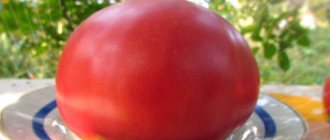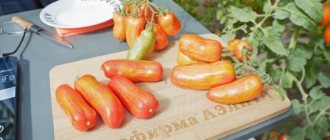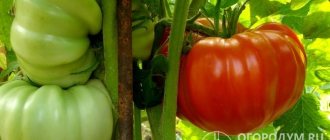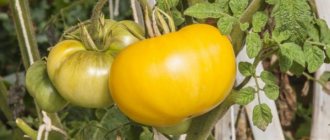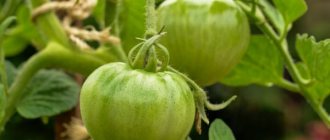Gardeners have long known the Pepper-shaped variety with small fruits. But Siberian breeders went further and in 2005 they developed an improved version of the old variety. The Pepper Giant tomato differs from its predecessor in the weight and taste of the fruit.
| Height | Landing location | Ripening time | Fruit color | Fruit size | Origin | Fruit shape |
| Tall | Greenhouse, Open ground | Mid-season | Reds | Average | Variety | Pepper-shaped |
Description of the pepper giant tomato variety with photo
Tomato Pepper-shaped giant is a variety bred by Siberian breeders (Schott Z.I., Gilev M.A.) at the beginning of the 21st century. The organization that submitted the application for registration of the variety is agro (Altai Territory, Barnaul). The variety was included in the register of breeding achievements in 2007. Approved for cultivation in most Russian regions:
- middle lane;
- Northwest;
- Volga region;
- Chernozem region;
- North Caucasus;
- Ural;
- Western and Eastern Siberia;
- Far East.
The description of the Pepper Giant tomato variety provides the following characteristics:
- indeterminate – grows throughout the season;
- tall – 150–200 cm;
- mid-ripening - fruits are formed in 110–120 days.
The bush is tall, with large dark green leaves. It tolerates temperature changes and night frosts well, so the variety is grown even in the northern regions. The inflorescences are of a simple type, the flowers are small and yellow. Each bunch produces 6–9 medium to large tomatoes.
Description of fruits
Tomatoes of the Pepper-shaped giant variety (pictured) have a characteristic elongated shape. The fruits are large - length 10–15 cm, weight on average 150–200 g. The skin is dense, bright red, with a pleasant gloss. There are few seeds, they are located in three or four chambers. The fruits are durable and transportable - they can be transported over long distances.
The pulp is fleshy, dense in consistency, tender. Since the peel is dense, it is better to remove it before preparing the dish by pouring boiling water over the fruit. The taste is described as excellent. It harmoniously combines moderate sweet tones with delicate sourness. Most summer residents appreciate these tomatoes for their good taste.
The Pepper Giant tomato has a bright red color and glossy skin.
Important! When stored in cool conditions, the Pepper Giant tomato does not lose its taste for eight weeks.
Variety varieties
The basic characteristics of tomatoes are the same on most points, but the varieties have differences: from color to the ability to withstand low night temperatures.
Giant
This variety belongs to the tall types and can grow up to 2 meters. Recommended for growing in greenhouse conditions. Fruit characteristics:
- 5-9 pieces on one branch;
- average weight – 150-200 grams;
- harvesting up to 6 kilograms of tomatoes per square meter.
The hybrid is sold by large producers on the seed market: Sibirsky Sad, Aelita.
Yellow
The peculiarity of this hybrid is its yellow color and a small number of leaves on the bush. When growing, it is recommended to leave 1 stem; pinching the hybrid is carried out regularly. Features of the variety:
- low resistance to sub-zero temperatures;
- light-loving, the need for constant access to a light source;
- The yield is high, 4 kilograms of fruit are harvested from one bush.
Summer residents love to use yellow pepper varieties to make canned assortments.
Orange
The hybrid has early ripening periods and is recommended for greenhouses or film greenhouses. In size it is ahead of the pepper-shaped yellow varieties, the fruits reach 220 grams. Orange varieties are distinguished by high yields; up to 9 kilograms of tomatoes are harvested from one bush.
Red
Varieties of red pepper tomatoes are especially popular. Hybrids are classified as indeterminate type. Features of varieties:
- gradual yield (harvesting lasts more than 2 months);
- one bush, subject to proper care, produces up to 9 kilograms of tomatoes;
- varieties are resistant to Fusarium infection.
Crimson
This hybrid was specially bred for growing in regions with low night temperatures. The varieties belong to the determinant type; the bush stops growing when it reaches 60 centimeters.
The crimson color makes the variety memorable; it differs from related species in density. The skin is harder, this property is used in preparations, when cooked using heat treatment.
Sturdy
This is a determinate variety that has high yields. Summer residents harvest about 5 kilograms of tomatoes from one bush, this is a good indicator for a mid-season, low-growing variety.
Striped
A hybrid of interesting colors. Those who choose it for cultivation for the first time do not immediately realize that the fruit is ready for harvest. The stripes are located from top to bottom, creating a feeling of under-ripeness.
Long Minusinsk
The variety was bred in a small town in the south of Siberia and is included in the state register. Tomatoes of the Minusinsk variety are red in color, the pepper-shaped fruits are especially elongated at the edges. Features of the fruit:
- average weight – up to 200 grams;
- resistant to low temperatures and diseases;
- unpretentious.
Summer residents call this type “pepper” because of its external similarity to red pepper pods.
Cuban black
The variety is of indeterminate type, the height of the bushes can reach 2.2 meters. The fruits are characterized as dense and juicy, prone to long-term storage.
Recommendations for growing:
- regular gartering and pinching;
- timely harvesting of fruits (due to the fragility of the branches, the weight of the tomatoes bends them to the ground.)
Pink
Varieties of this species are characterized by unusual coloring. Inside the pulp is even lighter, the number of seeds is minimal.
The fruits ripen 120 days after the detection of shoots. Pink tomatoes are recommended for growing in open ground in the south or southeast of the country.
Royal Sedek
The hybrid is a medium-ripening variety. Features of the plant:
- the height of the bushes reaches 1.6 meters in height;
- leaves on the branches are poorly developed;
- there are up to 5-6 fruits on the branch;
- The color is ordinary, the fruits have an even red color.
It is suitable for regions with temperature extremes and sudden changes in weather conditions.
Hugo
Tomatoes of this type were bred in the Czech Republic. A special feature was the size of the bright red fruits. Compared to other pepper tomatoes, they are large, reaching 350 grams. Recommended for growing in areas with temperate climates.
Characteristics of the pepper giant tomato
The Pepper Giant tomato becomes technically ripe 4 months after planting. The first harvest can be harvested in early July. Green fruits are left to ripen on the bush or placed in a dark, cool place for 10–15 days. Fruiting is extended, tomatoes are formed until the onset of the first frost. The last harvest is harvested at the end of September, and in warm regions - at the beginning of October.
Productivity and fruiting
The Pepper Giant variety is a medium-yielding variety. Each bush produces 2–2.5 kg when grown in greenhouse conditions.
| Yield indicator | Growing method | |
| Greenhouse | In an open garden | |
| From 1 bush, kg | 2–2,5 | 1,5–2 |
| from 1 m2, kg* | 9–10 | 6–8 |
*4 pepper giant tomatoes are placed per 1 m2, and when formed into 3 stems - no more than three plants.
Productivity is influenced by various factors. Despite the fact that the variety is resistant to adverse weather conditions, it is better to plant the bushes under a film cover or in a greenhouse. To increase productivity, it is recommended to follow the basic rules of agricultural technology:
- regular watering with warm, settled water;
- fertilizing with complex mineral and organic fertilizers 3–4 times per season;
- pinching a bush, forming 2–3 stems;
- garter to support;
- mulching plantings with peat, sawdust, humus;
- loosening and weeding - as necessary;
- Preventive treatment against diseases and insect pests.
The maximum yield of the Pepper-shaped giant tomato can be obtained when grown in a greenhouse
Area of application of fruits
Pepper giant tomatoes belong to the universal category. They are suitable for preparing various dishes and preparations:
- salads;
- vegetable slices;
- sauces;
- soups;
- lecho;
- caviar;
- whole fruit canning;
- freezing;
- drying;
- drying.
Resistance to diseases and pests
The variety is characterized by average resistance to late blight. May suffer from blossom end rot. Also, the yield of the Pepper-shaped giant variety may fall due to the influence of insect pests. Therefore, it is recommended to treat seedlings with fungicides immediately after transplanting into the greenhouse. The bushes are regularly inspected and, if necessary, insecticides or folk remedies are used to combat aphids, nematodes, wireworms, mole crickets and other pests.
More varieties of tomatoes in the pepper series
The first pepper-shaped tomatoes appeared in Russia about 20 years ago , and at first they were represented only by foreign hybrids and varieties. The first representative was included in the State Register of the Russian Federation in 2001.
Tomatoes in this series have different characteristics and colors : they are yellow, orange or crimson.
Yellow
The fruits ripen on the 120th day .
There are few leaves on the plant. The variety is indeterminate. The height of the main stem is 180 cm. Subject to the rules of agricultural technology, vegetable growers harvest up to 3 kg of crop from one bush. Yellow pepper tomatoes are grown both in greenhouses and in open ground. Up to 7 fruits are tied on one brush.
The average weight of one vegetable is 150 g . Tomatoes have an elongated shape with yellow skin and pulp. Tomatoes contain few seeds. The harvest is used both for preservation and for fresh consumption.
Orange
Pepper-shaped orange tomato is grown in greenhouse conditions . The culture belongs to the early varieties. Ripe vegetables are harvested 90–100 days after germination. The variety is indeterminate. The bush reaches a height of 1.8 m.
Up to 4 large fruits are tied on one brush. The weight of an average tomato is 180 g. The pulp is juicy and tender, the peel is thick and durable. When canned, tomatoes do not crack.
Crimson
Another interesting tomato variety is Pepper Raspberry. The plant is of a determinate type, that is, the bushes are limited in growth and grow compact . The size of the tomatoes is quite large. The average weight of one tomato is 180 g. At the stage of full ripening, the fruits acquire a crimson hue.
The ripening period is 100 days after germination , so the crop belongs to the early ripening varieties. Tomatoes have an excellent sugary taste. When growing in greenhouse conditions, from 4 to 6 kg of crop is harvested from one plant.
Sturdy
The plant belongs to the early varieties ; fruit ripening occurs on the 110th day after the sprouts appear. Determinate, standard variety. Small bushes reach a height of 40–50 cm.
The robust one tolerates any weather conditions well and has strong immunity to diseases . The color of the tomatoes is deep pink, with a small green spot at the stalk. The vegetables taste sweet. The weight of the tomato is 150 g. Vegetable growers harvest up to 4 kg of crop from one bush.
Advantages and disadvantages of the pepper giant tomato
Tomatoes are storable, the last fruits appear at the end of September. Therefore, even in mid-autumn you can eat fresh fruits that have retained their taste.
The pepper giant tomato is valued for its pleasant taste, good shelf life and transportability.
pros
- versatility of using tomatoes;
- possibility of growing in different regions;
- extended fruiting;
- long-term storage in cool conditions;
- original appearance.
Minuses
- average yield;
- low immunity;
- the need for stepsoning and shaping;
- needs a garter.
Harvesting and use of fruits
The harvest can be harvested as early as mid-summer - July; in open areas, fruiting begins at the end of the second summer month.
The formation and ripening of fruits continues until the onset of the first autumn frosts. In the fall, it is recommended to remove some of the inflorescences - the fruits may not have time to ripen and pinch the tops of the bush plant, which will stop their growth.
Tomatoes can be used fresh or used for canning for the winter. Vegetables make excellent summer salads and appetizers, pasta, sauce, and dietary children's dishes. They are of little use for juice.
Features of cultivation
The pepper giant tomato is grown in the traditional seedling way. Seeds begin to be sown 60–65 days before transplanting into the ground. The procedure is carried out in early March, but the specific period depends on the region. Use standard containers - boxes, containers, and after picking - cups or peat pots. Soil composition – surface layer of soil, humus and peat (2:1:1). The finished mixture can be purchased at the store.
Sowing depth is 1–1.5 cm, interval is 3–4 cm. In the first stages of cultivation, greenhouse conditions are created:
- the soil is regularly moistened;
- containers are placed in a warm place (+24–26 °C);
- Cover with film, which is periodically removed for ventilation.
After two leaves appear, they are picked, then complex mineral fertilizer is applied and grown without film at normal room temperature. 10–15 days before transplantation, they are hardened at a temperature of +15–16 °C.
If there is a lack of sunlight, pepper giant tomato seedlings need to be illuminated with a lamp
The seedlings are transferred to open ground in mid-May, and to the greenhouse a week earlier. At this point, their height reaches 30 cm, and each of them has one flower raceme and at least five leaves. Pepper giant tomato bushes are planted at a distance of 50 cm from each other, leaving 60–70 cm between rows. In the future, their care is standard:
- Water 2 times a week. The water is prepared in advance: it must be left for 12 hours.
- Feed two weeks after transplantation, then twice more: at the flowering stage and after it. Complex mineral fertilizers with nitrogen, phosphorus and potassium are alternated with organic matter - chicken manure, infusion of freshly cut grass, mullein. During fruiting, you can add sodium humate or ash solution - this will improve the taste of the tomatoes.
- Plantings are immediately mulched with peat, humus, sawdust or straw.
- Weeding and loosening are carried out as necessary.
- 2–3 stepsons are left on the bush, forming a plant with 2–3 stems.
- When the plants reach 50–60 cm, they are tied to a support.
Pepper giant tomato bushes need garter
Advice! As soon as the first flower cluster is formed, all foliage below it is cut off.
Description and characteristics
Having gained popularity relatively recently, the Pepper-shaped tomato (the description and characteristics of the variety will be presented below) began to be successfully grown by Russian gardeners. The variety is classified as tall, since the maximum height of the bush reaches one and a half meters, or even higher. Therefore, an adult plant requires good support. Don’t forget to take stepson, as the bush branches a lot. The bush also requires support for the reason that it has giant fruits that are orange, yellow, red or pink, like peppers. A striped tomato looks very interesting, from an aesthetic and culinary point of view, usually red with yellowish streaks.
Tomato Pepper
The laying of the first brush occurs somewhere between the 6th and 11th sheet, the next brushes are located every three sheets. Each cluster grows up to 7-8 fleshy fruits with a sweetish taste, with a small amount of seeds of large, elongated fruits. The average weight of the fruit is about 80 grams with a length of up to 15 cm. Together with the elongated shape, this provides an excellent opportunity to preserve them entirely without cutting them.
The variety is productive - up to 10 or more kg can be harvested from one square of plantings. It is classified as mid-season - about 110-115 days pass from planting to harvesting the first harvest. Fruiting lasts from mid-July to the last days of October.
The variety is frost-resistant, so it can be grown not only in a greenhouse, but also in open ground. This variety will not only produce fruits, but will also decorate your garden with its uniqueness. In addition, during practice, the tomato showed an excellent property - resistance to almost all tomato diseases and pests.
Pest and disease control
The pepper giant tomato does not have strong immunity. Therefore, seedlings are treated with fungicides a few days before transplanting into the ground or immediately after. You can use any effective drug (one to choose from):
- Bordeaux mixture;
- "Ordan";
- "Tattu";
- "Profit";
- "Fitosporin".
To destroy a colony of insects, insecticides are used:
- "Fitoverm";
- "Karate";
- "Spark";
- "Confidor";
- "Match".
You can also treat with homemade solutions based on tobacco dust, ash and soap, baking soda, onion peels, chili peppers, and garlic cloves.
Advice! It is not advisable to grow tomatoes where other Solanaceae grew last season, for example, potatoes, peppers, eggplants, sunflowers. The best crop predecessors are legumes, grains, cucumbers and any root vegetables (carrots, beets, radishes).
Reviews from gardeners
Those who tried to grow Pepper-shaped giant tomatoes on their plots were satisfied.
Gardeners recommend cutting off the ovaries that form in late summer and early autumn to give the already formed fruits the opportunity to gain the required weight and have time to ripen.
It is also noted that an excess of moisture in the air combined with high temperatures can stop flowering. It is better to ventilate the greenhouse regularly. Unripe fruits can be removed from the branches; they quickly reach the stage of ripeness in indoor conditions.
This variety is an excellent option for those who love tall bush vegetables. The tomato row of such a crop looks impressive, and the attractive, large, bright fruits with a shape reminiscent of pepper will not leave you indifferent.
Landing
Seedlings are planted in March. The box is placed in a warm place and covered with film, which is removed after germination of the seedlings. Then the seedlings are grown on a windowsill on the sunny side at a temperature of 16˚C. When 1-2 leaves appear, it is transplanted into cups.
7-10 days before planting, hardening begins:
- Once a day, plants are sprayed with cool water;
- Every day the seedlings are taken outside for 15-20 minutes.
The seedlings are transplanted to a permanent place 60-65 days after sowing, when it has 5-7 true leaves and one flower cluster. Planted according to the 60x50 cm pattern. Per 1 sq. m there should not be more than 4 bushes.
